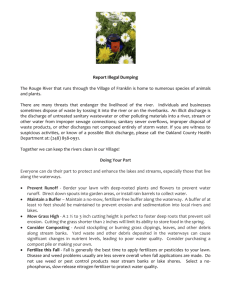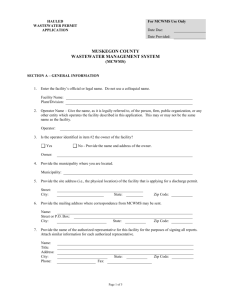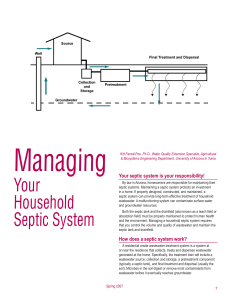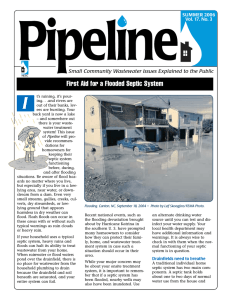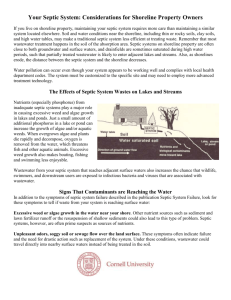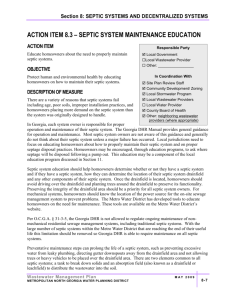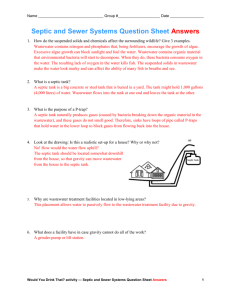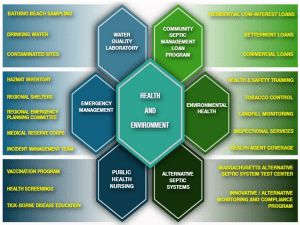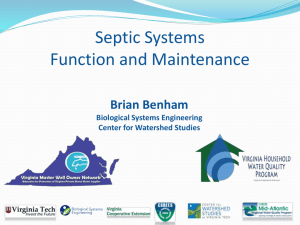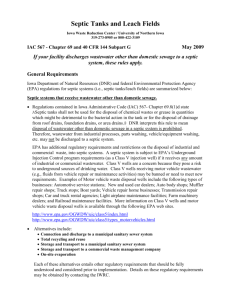Failure - Water Quality Information for Consumers
advertisement
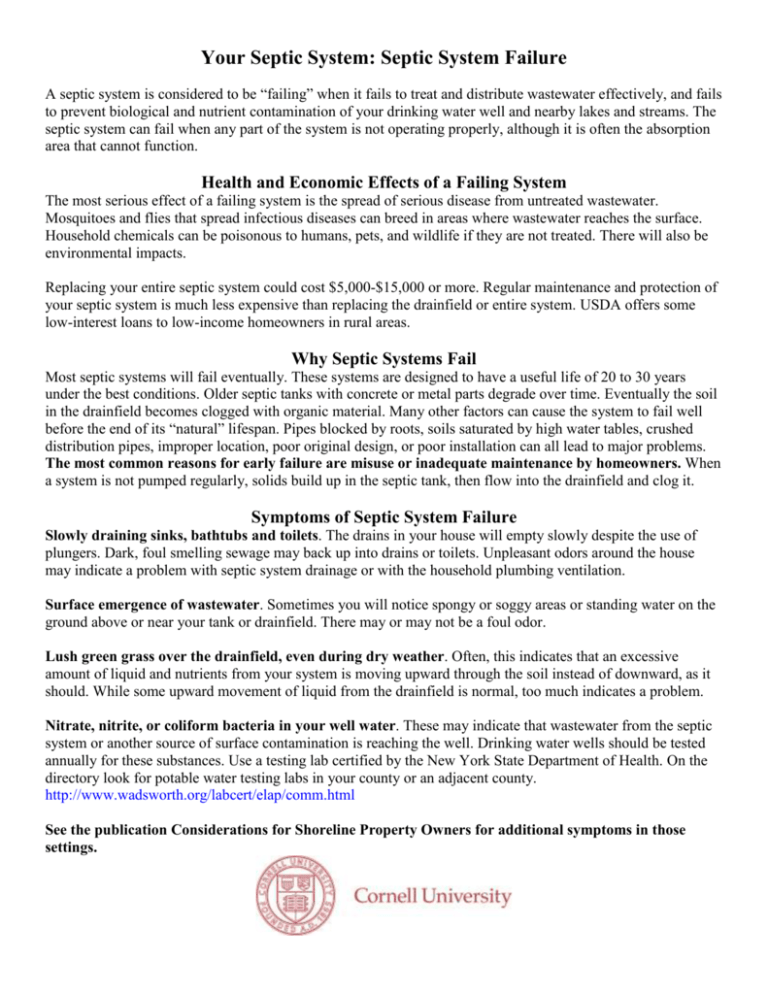
Your Septic System: Septic System Failure A septic system is considered to be “failing” when it fails to treat and distribute wastewater effectively, and fails to prevent biological and nutrient contamination of your drinking water well and nearby lakes and streams. The septic system can fail when any part of the system is not operating properly, although it is often the absorption area that cannot function. Health and Economic Effects of a Failing System The most serious effect of a failing system is the spread of serious disease from untreated wastewater. Mosquitoes and flies that spread infectious diseases can breed in areas where wastewater reaches the surface. Household chemicals can be poisonous to humans, pets, and wildlife if they are not treated. There will also be environmental impacts. Replacing your entire septic system could cost $5,000-$15,000 or more. Regular maintenance and protection of your septic system is much less expensive than replacing the drainfield or entire system. USDA offers some low-interest loans to low-income homeowners in rural areas. Why Septic Systems Fail Most septic systems will fail eventually. These systems are designed to have a useful life of 20 to 30 years under the best conditions. Older septic tanks with concrete or metal parts degrade over time. Eventually the soil in the drainfield becomes clogged with organic material. Many other factors can cause the system to fail well before the end of its “natural” lifespan. Pipes blocked by roots, soils saturated by high water tables, crushed distribution pipes, improper location, poor original design, or poor installation can all lead to major problems. The most common reasons for early failure are misuse or inadequate maintenance by homeowners. When a system is not pumped regularly, solids build up in the septic tank, then flow into the drainfield and clog it. Symptoms of Septic System Failure Slowly draining sinks, bathtubs and toilets. The drains in your house will empty slowly despite the use of plungers. Dark, foul smelling sewage may back up into drains or toilets. Unpleasant odors around the house may indicate a problem with septic system drainage or with the household plumbing ventilation. Surface emergence of wastewater. Sometimes you will notice spongy or soggy areas or standing water on the ground above or near your tank or drainfield. There may or may not be a foul odor. Lush green grass over the drainfield, even during dry weather. Often, this indicates that an excessive amount of liquid and nutrients from your system is moving upward through the soil instead of downward, as it should. While some upward movement of liquid from the drainfield is normal, too much indicates a problem. Nitrate, nitrite, or coliform bacteria in your well water. These may indicate that wastewater from the septic system or another source of surface contamination is reaching the well. Drinking water wells should be tested annually for these substances. Use a testing lab certified by the New York State Department of Health. On the directory look for potable water testing labs in your county or an adjacent county. http://www.wadsworth.org/labcert/elap/comm.html See the publication Considerations for Shoreline Property Owners for additional symptoms in those settings. What to Do if Your System Fails: Immediate Actions First, call your local health department. Health department staff have the expertise to assess your situation quickly and offer advice. See contact information on the back of the Your Septic System folder. Fence the septic system area. If liquid waste seeps to the surface, keep people and pets away. Exercise caution in working near an opened septic tank. Toxic and/or explosive gases may be present. Have your septic tank pumped. This will help the problem temporarily, especially when it is combined with drastic water conservation. If the drainfield is still in good condition and the septic tank is large enough for the wastewater volume leaving the household, pumping may be an effective solution. Conserve water in your home. This is particularly effective if your system has not failed completely. It can help lessen the problem for a short time. See the publication on Water Conservation for tips. What to Do If the System Fails: Long-Term Options Replace the drainfield or entire system. This type of work only should be performed by a qualified professional and according to local regulations. Contact your county health department to see what changes require a permit. See the publication Building or Remodeling a Home with a Septic System for tips and design features to include. Increase the size of the drainfield. This may help if the original drainfield was too small for the size of your family or if the soil does not allow water to percolate very well, provided that the tank size is adequate. Conserve water in your home on a long-term basis. See the Water Conservation publication for tips. If periodically saturated soils are a source of problems, consider installing perimeter drains. This involves installing tile drains underground at a distance around the drainfield to help lower soil water levels. It works in some but not all situations and requires the assistance of a qualified professional. The location should also be evaluated by your local health department. Incorporate advanced or alternative treatment technologies. On small lots, property near shorelines, or land with inadequate soil for a traditional drainfield, other technologies may be used as part of your on-site wastewater treatment system. See the publication on Alternative and Advanced OWTS. If septic system failures are common in your area, consider participating in the development of a small community cluster system or other on-site wastewater treatment system (OWTS) alternative. These intermediate systems are designed for small communities and some rural areas and can be more cost-effective than a conventional sewage treatment plant. Connect to a municipal sewage system, if one is available. Consider the balance between initial and longterm costs versus reduced worry and lowered maintenance. The original version of this publication was developed by Cornell Cooperative Extension (CCE) via a grant from the NYS Water Resources Institute with funds provided by the NY State Legislature through the Dept. of Agriculture and Markets. The project team included A. Meyer, M. Keith, J. Saumier, and M. Shortlidge of Dutchess, Putnam, Rockland, and Westchester Counties. It was adapted from a Michigan State University Cooperative Extension System bulletin by D. Solomon and E. Dersch. It was revised by A. Galford with input from county and NYS health departments and the CCE Water Resources PWT. This material is based upon work supported by Smith-Lever funds from the National Institute of Food and Agriculture, U.S. Department of Agriculture. Any opinions, findings, conclusions, or recommendations expressed in this publication are those of the authors and do not necessarily reflect the view of the U.S. Dept. of Agriculture. Printed 01/2013.
